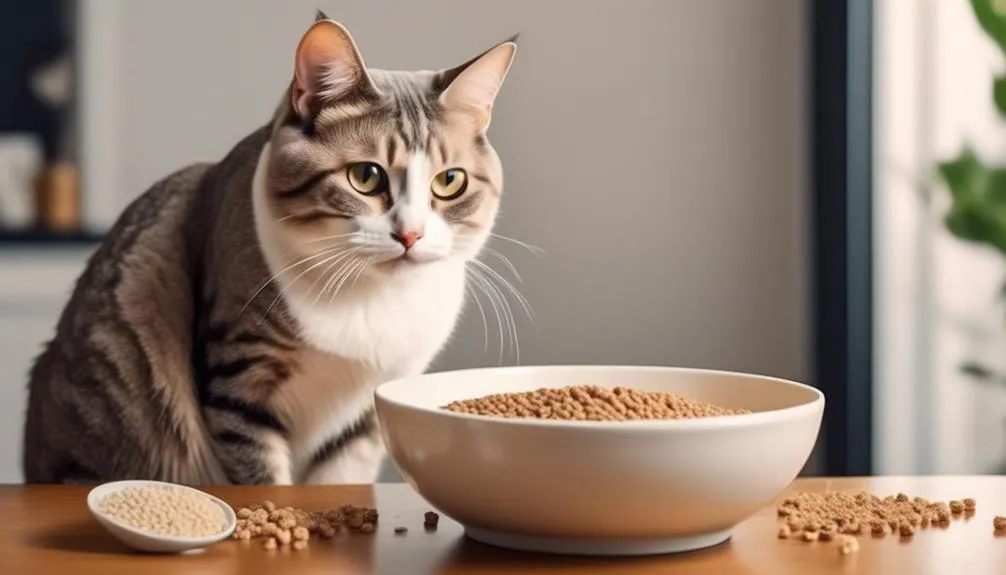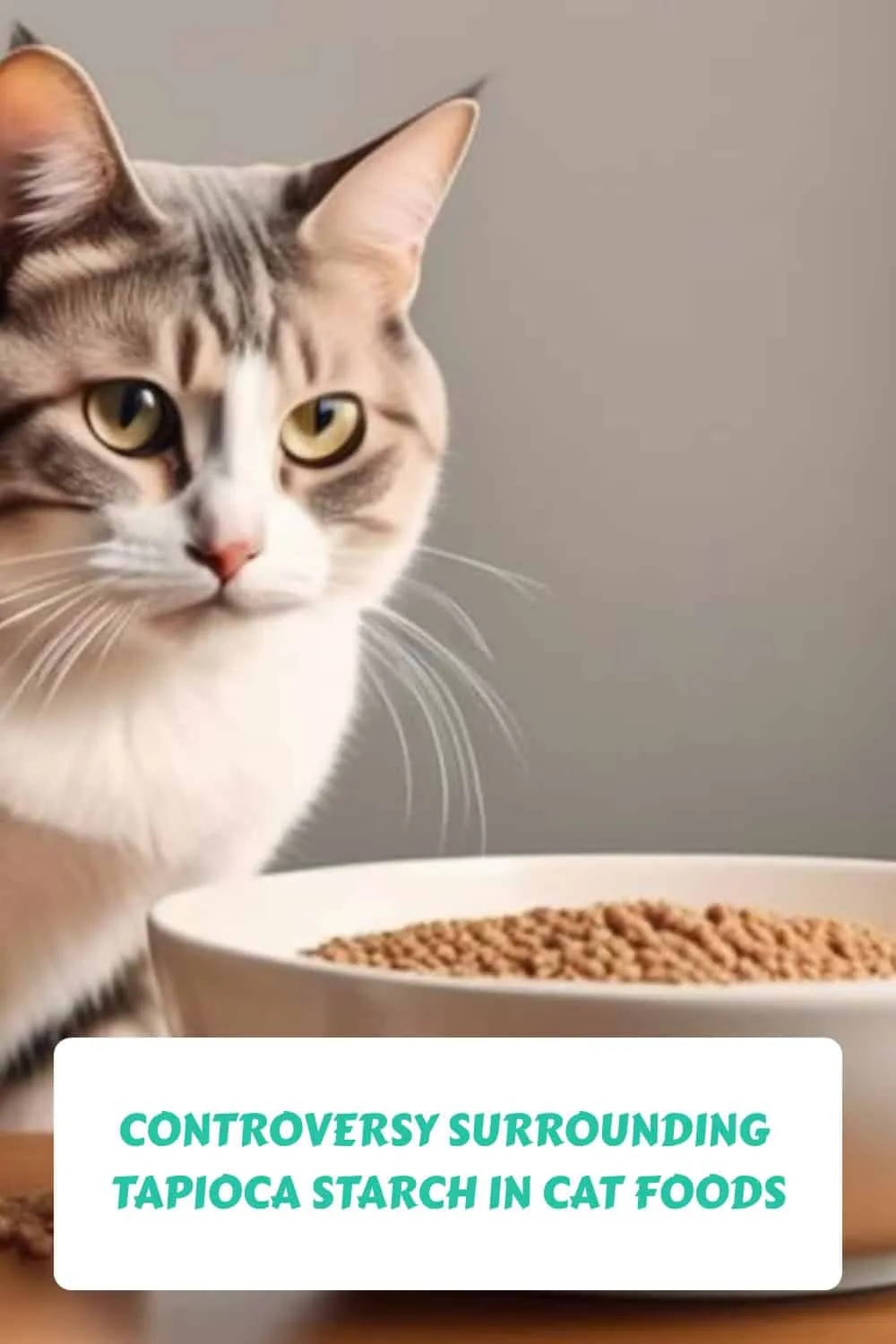The Best Fluffy Pancakes recipe you will fall in love with. Full of tips and tricks to help you make the best pancakes.

The inclusion of tapioca starch in cat foods has become a subject of intense debate and controversy, capturing the attention of both pet owners and nutrition experts.
As a popular substitute for gluten-containing grains in grain-free pet food formulas, tapioca starch acts as a binder and carbohydrate source.
However, concerns have been raised regarding its nutritional value and potential cyanide content. While tapioca starch lacks the nutritional benefits of whole grains and undergoes extensive processing, properly processed tapioca starch does not contain cyanide and has not been linked to any reported cases of poisoning.
Nevertheless, the ongoing discussion surrounding grain-free diets and the overall nutritional balance of cat food products necessitates a deeper exploration of these concerns.
Key Takeaways
- Tapioca starch is commonly used as a binder and carbohydrate in grain-free cat foods as a replacement for gluten-containing grains.
- Tapioca starch lacks nutritional value compared to whole grains and has less protein than rice or wheat.
- Tapioca starch does not contain cyanide, as it is derived from sweet cassava, which is processed to remove toxins.
- Grain-free diets may not necessarily be healthier for cats, and it is important to consider the overall nutritional balance and quality of ingredients in cat food.
Tapioca Starch as Grain Substitute
Tapioca starch serves as a viable grain substitute in cat foods, providing the necessary texture and consistency while catering to consumer demand for grain-free options.
When compared to other grain substitutes, such as rice or wheat, tapioca starch offers several potential health benefits. Firstly, tapioca starch is gluten-free, making it suitable for cats with gluten sensitivities or allergies. Additionally, tapioca starch is easily digestible, which can aid in preventing digestive issues in cats. It is also a low-fat and low-protein option, which can be beneficial for cats with specific dietary needs, such as those with kidney disease.
However, it is important to note that tapioca starch does not offer the same nutritional value as whole grains, as it contains fewer minerals and protein.
Nutritional Value of Tapioca Starch
The nutritional value of tapioca starch can be evaluated based on its composition and processing methods. While tapioca starch does not provide significant nutritional benefits compared to whole grains, it serves as a binder and carbohydrate source in cat food. The intensive processing required to produce tapioca starch diminishes its nutritional value, resulting in a product with limited minerals and protein content.
However, tapioca starch is a cost-effective alternative to gluten-containing or gluten-free grains in pet foods, assisting in creating the desired texture and consistency. It is essential to consider processing methods and alternative binders when assessing the nutritional value of tapioca starch in cat foods.
Absence of Cyanide in Tapioca Starch
The safety of tapioca starch in cat foods can be assured through an examination of its absence of cyanide. While cassava, the plant from which tapioca starch is derived, can produce cyanide if not processed properly, the tapioca starch used in cat foods comes from sweet cassava, which is processed to remove toxins. The cyanide removal process ensures that tapioca starch is safe for consumption.
There have been no pet food recalls related to cyanide levels from tapioca starch, indicating its safety. It is important to note that bitter cassava, which contains more cyanogenic glycosides, is not used to make tapioca starch. Thus, when properly processed, tapioca starch does not contain cyanide and can be confidently included in cat foods.
Reputation of Cassava as Toxic
Is cassava truly toxic or is its reputation exaggerated?
Cassava, a root vegetable, has gained a reputation for toxicity due to the potential cyanide content in its leaves and roots. However, it is important to understand that not all cassava varieties are toxic, and the toxicity risks can be mitigated through proper processing. Here are some key points to consider:
- Cultural Significance: Cassava is a staple food for millions of people in Africa, Asia, and South America, where it is consumed daily without adverse effects.
- Processing Methods: Traditional methods such as soaking, fermenting, and cooking can effectively remove toxins from cassava.
- Bitter vs Sweet Cassava: Bitter cassava contains higher levels of cyanogenic glycosides and requires extensive processing to be safe for consumption. Sweet cassava, used to produce tapioca starch, is low in toxins and considered safe.
- Proper Processing: Tapioca starch undergoes thorough processing to ensure the removal of toxins, making it safe for use in cat foods.
- Lack of Reported Cases: There have been no reported cases of poisoning related to properly processed tapioca starch.
It is important to recognize the cultural significance of cassava and the efforts made to ensure its safety for consumption. The reputation of cassava as toxic may be exaggerated, and when properly processed, it poses minimal risks.
Poisonings Associated With Cassava Consumption
Cassava consumption has been associated with a number of poisonings, particularly in regions where proper processing methods are not followed or where bitter cassava is used. Cassava poisoning incidents have been reported in areas such as Africa and Venezuela, where malnourished populations and low protein levels in the diet contribute to vulnerability to toxins.
Tragic poisonings have occurred, such as in Uganda, where children were poisoned by chips made with cassava flour from a wild form of the plant. It is important to note that these poisonings are not directly linked to properly processed tapioca starch, which is derived from sweet cassava and undergoes toxin removal during processing.
As long as the correct processing methods are followed, cassava toxicity concerns can be mitigated, and the use of tapioca starch in cat foods remains safe.
Misconception of Grain-Free Diets
Grain-free diets for cats have gained popularity due to a marketing misconception surrounding their supposed health benefits. Pet food companies have capitalized on this trend, promoting grain-free diets as a healthier option for cats. However, it is important to separate marketing tactics from scientific evidence when considering the health risks associated with these diets.
Here are five key points to consider:
- Grain-free diets may not necessarily be healthier for cats.
- The belief that grains are inherently harmful in cat food is a misconception.
- Cats are obligate carnivores and require a balance of protein, fat, and carbohydrates in their diet.
- Some grain-free diets may lack essential nutrients, leading to potential health problems.
- It is crucial to consult with a veterinarian to ensure that a cat's diet is nutritionally balanced and appropriate for their individual needs.
Considerations for Cat Health
Considerations for cat health should prioritize a balanced and nutritionally complete diet that meets their unique nutritional needs. While tapioca starch is commonly used as a binder in cat foods, it is important to be aware of potential risks associated with its use.
Tapioca starch itself does not have significant nutritional value compared to whole grains, as it contains fewer minerals and protein. Additionally, the intensive processing required to produce tapioca starch diminishes its nutritional value.
To mitigate these concerns, pet owners may consider alternative binders that offer more nutritional benefits, such as whole grains like rice or gluten-free grains like quinoa.
It is crucial to carefully evaluate the overall nutritional balance and quality of ingredients in cat food to ensure the best possible health outcomes for our feline companions.
Conclusion and Recommendations
Based on the nutritional value and potential risks associated with tapioca starch in cat foods, it is important for pet owners to carefully consider the overall composition and quality of ingredients when selecting a balanced and nutritionally complete diet for their feline companions.
Here are some key conclusions and recommendations:
- Be aware of the implications of tapioca starch in cat food manufacturing, as it primarily serves as a binder and carbohydrate source, lacking the nutritional value of whole grains.
- Understand that consumer demand plays a significant role in the production of grain-free pet foods, but it is important to critically evaluate the claims and marketing tactics surrounding these products.
- Prioritize the nutritional needs of your cat over dietary trends, as grain-free diets may not necessarily be healthier for cats.
- Consult with a veterinarian to determine the most appropriate diet for your cat, taking into consideration their specific health needs and dietary preferences.
- Opt for cat foods that prioritize high-quality ingredients and nutritional balance, rather than relying solely on the absence of specific ingredients like grains.
Frequently Asked Questions
Are There Any Nutritional Benefits to Using Tapioca Starch in Cat Food Compared to Other Grain Substitutes?
There are no significant nutritional benefits to using tapioca starch in cat food compared to other grain substitutes. Its primary function is as a binder and carbohydrate source. The controversy surrounding it relates to digestive issues and the overall nutritional balance of cat food.
Can Tapioca Starch Cause Any Digestive Issues or Allergies in Cats?
Tapioca starch is generally well tolerated by cats and does not commonly cause digestive issues or allergies. However, individual sensitivities can vary, so it's important to monitor your cat's response and consult with a veterinarian if concerns arise.
Is There a Risk of Cyanide Poisoning in Cats From Consuming Tapioca Starch?
There is no risk of cyanide poisoning in cats from consuming tapioca starch. The processing of sweet cassava, from which tapioca starch is derived, removes toxins. Tapioca starch is generally well-tolerated by cats and does not cause digestive issues or allergies.
How Does the Processing of Tapioca Starch Ensure the Removal of Toxins From Cassava?
Tapioca starch is processed from sweet cassava, which undergoes specific methods to ensure the removal of toxins. These processing methods involve washing, grinding, and soaking the cassava, followed by thorough cooking or baking to eliminate any potential toxins, ensuring the safety of tapioca starch.
What Are the Potential Risks of Using Cassava as a Source of Starch in Cat Food?
Potential health concerns associated with using cassava as a source of starch in cat food include the risk of cyanide poisoning if not properly processed. Alternative starch sources should be considered to ensure the safety and nutritional balance of cat food.
Conclusion
In conclusion, the controversy surrounding the use of tapioca starch in cat foods highlights the importance of carefully considering the nutritional balance and ingredient quality in pet food products.
Tapioca starch serves as a substitute for gluten-containing grains, but it lacks the nutritional value found in whole grains and contains fewer proteins. However, properly processed tapioca starch does not contain cyanide and has not been linked to any reported cases of poisoning.
Pet owners should carefully evaluate the overall nutritional content of cat foods to ensure the health and well-being of their feline companions.










